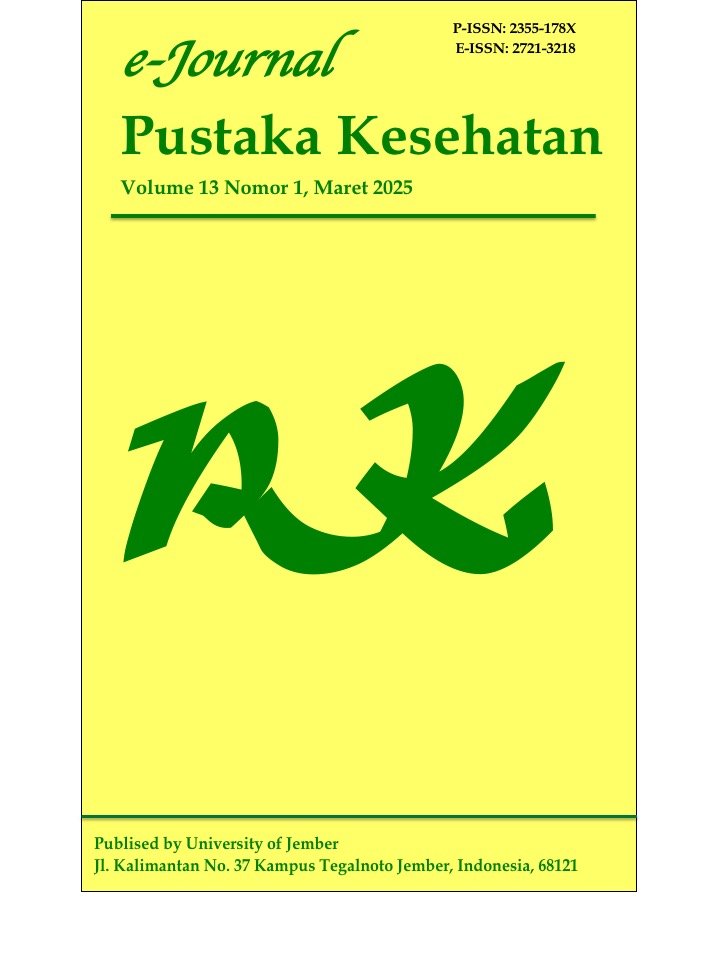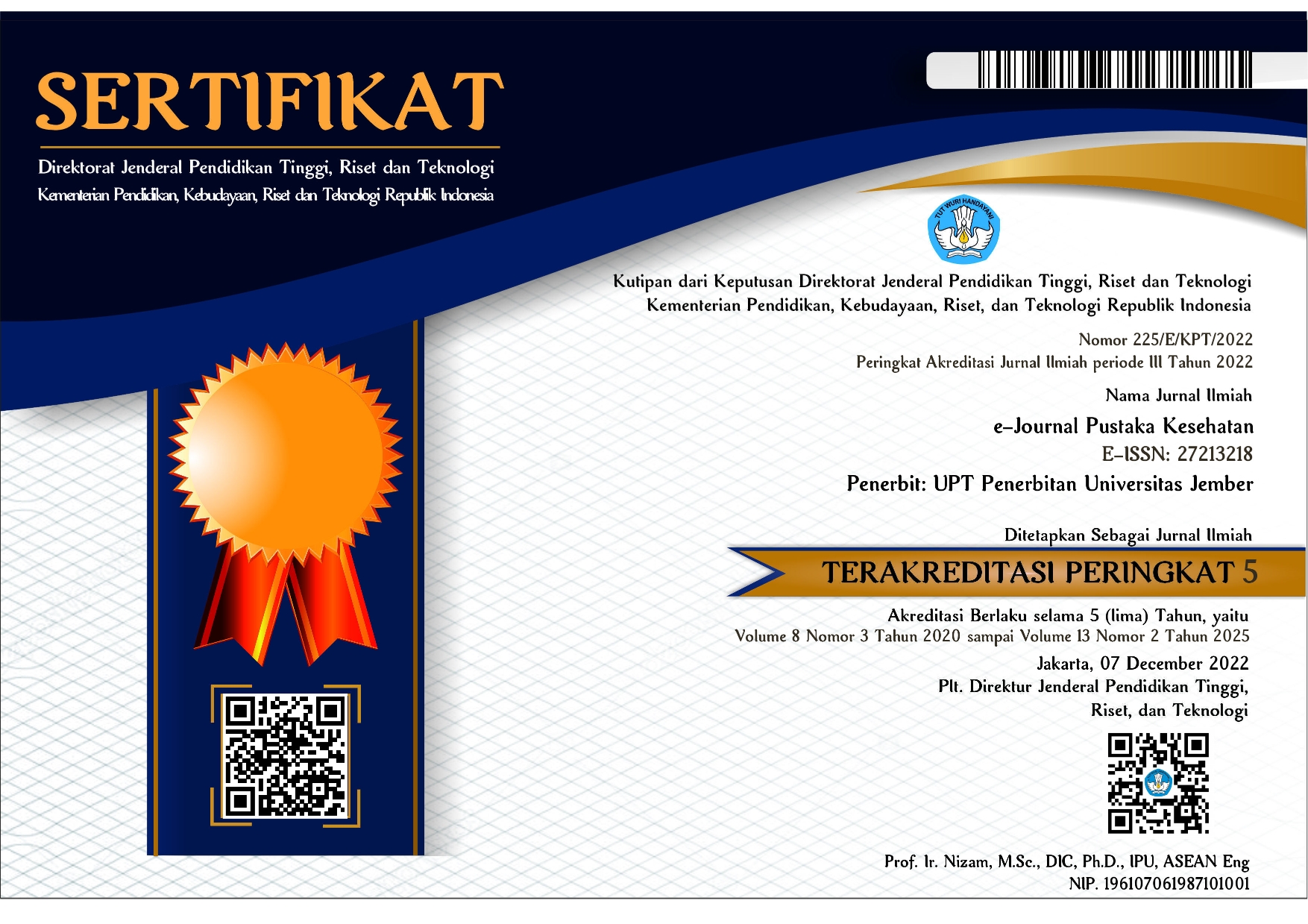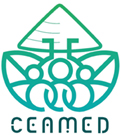Kemampuan Pasta Gigi yang Mengandung Ekstrak Biji Kopi Robusta (Coffea canephora) dalam Menghambat Pertumbuhan Bakteri Fusobacterium nucleatum
Keywords:
antibacterial, Fusobacterium nucleatum, periodontitis, robusta coffee, toothpasteAbstract
Fusobacterium nucleatum is a gram-negative obligate anaerobic bacterium that is most dominantly found in the oral cavity and plays an important role in periodontitis pathology. Periodontitis can be prevented by controlling plaque, namely, brushing teeth. Therefore, toothpaste needs to be optimized by adding an antibacterial substance. The robusta coffee (Coffea canephora) contains caffeine, phenols, trigonelline, chlorogenic acid, saponins, tannins, and triterpenoids, which have proven to be antibacterial. This study aimed to assess the ability of toothpaste containing robusta coffee bean extract to inhibit the growth of F. nucleatum. Robusta coffee beans were extracted using the maceration method and formulated into toothpaste with concentrations of 12.5%, 25%, and 50%. Antibacterial tests were carried out by the well diffusion method on MHA media that had been inoculated with F. nucleatum and the measured the diameter of the inhibition zone. The result showed that there was a significant difference in the inhibition zone diameter between the group positive control, the negative control, and toothpaste containing robusta coffee bean extract 12.5%, 25%, and 50%. The largest inhibition zone formed consecutively was in toothpaste containing robusta coffee bean extract 50%, 25%, and 12,5%. It can be concluded that toothpaste containing robusta coffee bean extract with concentrations of 12.5%, 25%, and 50% can inhibit the growth of F. nucleatum.
Downloads
References
[1] Kementrian Kesehatan Republik Indonesia. Laporan Nasional Riskesdas 2018. Jakarta: Lembaga Penerbit Badan Penelitian dan Pengembangan Kesehatan (LPB).
[2] Newman MG, Takei HH, Klokkevold PR, Carranza FA. et al.. 2019. Newman and Carranza’s clinical periodontology (Thirteenth edition NV-1 online resource (xxiii, 872, 110 pages) : illustrations (chiefly color)). Elsevier Philadelphia, PA. https://doi.org/ LK - https://worldcat.org/title/1043758752
[3] Astuti LA, Anas R, Hasanuddin NR, Pamewa K, Chotimah C, Ridha DAP. (2021). Efektivitas Ekstrak Etanol Tanaman Sarang Semut Terhadap Daya Hambat Bakteri Fusobacterium nucleatum (In Vitro). Sinnun Maxillofacial Journal, 2(01), 8–17. https://doi.org/10.33096/smj.v2i01.65
[4] Hakima AN, Ermawati T, Harmono H, (2020). Daya Hambat Ekstrak Biji Kopi Robusta (Coffea canephora) terhadap Pertumbuhan Fusobacterium nucleatum. Stomatognatic (J.K.G Unej), 17, 20–24.
[5] Wulandari A, Arina YMD, Pujiastuti P. (2023). Daya Hambat Pasta Gigiyang MengandungEkstrak Biji Kopi Robusta (Coffea canephora) terhadap Pertumbuhan Bakteri Porphyromonas gingivalis. Jurnal Penelitian Kesehatan Suara Forikes, 4(1), 31–36.
[6] Purnomowati RD, Prasetiowati LE, Sulastri S. (2022). Perawatan kesehatan gigi dan mulut menggunakan pasta gigi mengandung fluor dan herbal terhadap perubahan pH saliva. Holistik Jurnal Kesehatan, 16(1), 42–51. https://doi.org/10.33024/hjk.v16i1.6042
[7] Coimbra L, Costa IM, Evangelista JG, Figueiredo A. (2023). Food allergens in oral care products. Scientific Reports, 13(1), 1–8. https://doi.org/10.1038/s41598-023- 33125-y
[8] Denaxa D, Arkwright PD. (2020). Fennel as a cause of immediate hypersensitivity to toothpaste. Annals of Allergy, Asthma and Immunology, 125(1), 99–100. https://doi.org/10.1016/j.anai.2020.03.030
[9] Biria M, Rezvani Y, Roodgarian R, Rabbani A, Iranparvar P. (2022). Antibacterial effect of an herbal toothpaste containing Bamboo salt: a randomized double-blinded controlled clinical trial. BMC Oral Health,22(1), 1–8. https://doi.org/10.1186/s12903-022-02224-z
[10] Dianastri RNT, Astuti P, Prasetya RC. (2021). Daya Hambat Ekstrak Biji Kopi Robusta (Coffea Canephora) terhadap Bakteri Porphyromonas gingivalis (in vitro). STOMATOGNATIC - Jurnal Kedokteran Gigi, 18(2):69.
https://doi.org/10.19184/stoma.v18i2.28060
[11] Budi D, Mushollaeni W, Yusianto Y, Rahmawati A. (2020). Karakterisasi Kopi Bubuk Robusta (Coffea canephora) Tulungrejo Terfermnetasi dengan Ragi Saccharomyces cerevisiae. Jurnal Agroindustri, 10(2),129–138. https://doi.org/10.31186/j.agroindustri.10.2.12 9-138
[12] Sani M, Sukainah A, Wijaya M. (2023). Fermentasi Biji Kopi Robusta (Coffea canephora) menggunakan Aspergillus niger dalam Upaya Menurunkan Kandungan Kafein. Jurnal Pendidikan Teknologi Pertanian, 9(1), 83-96.
[13] Prasasti RN, Sari DS, Pujiastuti P. (2022). the Effectiveness of Using Toothpaste Containing Robusta Coffee Bean Extract in Inhibiting the Formation of Dental Plaque. ODONTO : Dental Journal, 9(1), 12.
https://doi.org/10.30659/odj.9.1.12-20
[14] Suparno NR, Putri CS, Camalin CMS. (2021). Pasta Gigi Ekstrak Etanol Daun Sirih, Biji Pinang, Gambir Terhadap Hambatan Bakteri Pseudomonas Aeruginosa. JIKG (Jurnal Ilmu Kedokteran Gigi), 3(2), 6–13. https://doi.org/10.23917/jikg.v3i2.12349
[15] Febriani A, Koriah S, Syafriana V. (2023). Studi Literatur Aktivitas Antibakteri Ekstrak Daun, Kulit Buah, Biji Kopi Arabika (Coffea arabica) dan Robusta (Coffea canephora) Terhadap Berbagai Bakteri Literature Review on Antibacterial Activity of Leaf, Fruit Peel, Seed Extracts of Arabica(Coffea a. Sainstech Farma: Jurnal Ilmu Kefarmasian, 16(2), 94–102.
[16] Diah JD, Wrasiati LP, Wartini NM. (2018). Karakterisasi Ekstrak Ampas Kopi Bubuk Robusta (Coffea canephora) pada Perlakuan Konsentrasi Pelarut Etanol dan Suhu Maserasi. Jurnal Rekayasa Dan Manajemen Agroindustri, 6(3), 243.
https://doi.org/10.24843/jrma.2018.v06.i03. p08
[17] Ginting R, Panggabean EA, Tarigan
EL. (2021). Efektivitas Ekstrak Biji Kopi Robusta (Coffea Canephora) Dalam Mengurangi Bakteri Staphylococcus Epidermis.
[18] Woziwodzka A, Krychowiak-Maśnicka M, Gołuński G, Łosiewska A, Borowik A, Wyrzykowski D, Piosik J. (2022). New Life of an Old Drug: Caffeine as a Modulator of Antibacterial Activity of Commonly Used Antibiotics. Pharmaceuticals,15(7),1–17. https://doi.org/10.3390/ph15070872
[19] Amwalia AD, Harun YZ, Yuwono HS. (2021). Uji Daya Hambat dan Daya Bunuh Ekstrak Air Kopi Robusta (Coffea Cenaphora) terhadap Pertumbuhan Bakteri Methicillin Resistant Staphylococcus Aureus (In Vitro). Prosiding Pendidikan Dokter,7(1), 663–667. http://karyailmiah.unisba.ac.id/index.php/do kter/article/view/26815
[20] Maheswari RA, Krismariono A, Bargowo L. (2018). Daya hambat ekstrak biji kopi robusta (Coffea canephora) terhadap pertumbuhan bakteri plak. July 2015, 16–20.
[21] Hasanah N, Gultom ES. (2020). Uji Aktivitas Antibakteri Ekstrak Metanol Daun Kirinyuh (Chromolaena odorata) terhadap Bakteri MDR (Multi Drug Resistant) dengan Metode KLT Bioautografi. Jurnal Biosains, 6(2), 45.
https://doi.org/10.24114/jbio.v6i2.16600
[22] Alfaridz F, Amalia R. (2019). Review Jurnal : Klasifikasi Dan Aktivitas Farmakologi Dari Senyawa Aktif Flavonoid. Farmaka, 3, 1–9.
[23] Nomer NMGR, Duniaji AS., Nocianitri KA. (2019). Kandungan Senyawa Flavonoid dan Antosianin Ekstrak Kayu Secang (Caesalpinia sappan L.) serta Aktivitas Antibakteri terhadap Vibrio cholerae. Jurnal Ilmu Dan Teknologi Pangan (ITEPA), 8(2), 216.
https://doi.org/10.24843/itepa.2019.v08.i02. p12
[24] Indrayani YP, Amrullah HU. (2022). Studi Perbandingan Kandungan Asam Klorogenat pada Kopi. Jurnal Ilmiah Multi Disiplin Indonesia, 2(1), 680–691.
[25] Yosboonruang A, Ontawong A, Thapmamang J, Duangjai A. (2022). Antibacterial Activity of Coffea robusta Leaf Extract against Foodborne Pathogens. Journal of Microbiology and Biotechnology, 32(8), 1003–1010.
https://doi.org/10.4014/jmb.2204.04003
[26] Rini AA, Supriatno, Rahmatan H. (2017). Skrining Fitokimia dan Uji Antibakteri Ekstrak Etanol BUAH KAWISTA (Limonia Acidissima L.) dari Daerah Kabupaten Aceh Besar terhadap Bakteri Escherichia Coli. Jurnal Ilmiah Mahasiswa Keguruan Dan Ilmu Pendidikan Unsyiah, 2(1), 1–12.
[27] Aryadi MI, Arfi F, Harahap MR. (2020). Perbandingan Kadar Kafein dalam Kopi Robusta (Coffea canephora), Kopi Arabika (Coffes arabica) dan Kopi Liberika (Coffea liberica) dengan Metode Spektrofotometri UV-Vis. Amina, 2(2), 64–
70.
[28] Wijaya W, Ridwan RD, Budi HS. (2017). Antibacterial ability of arabica (Coffea arabica) and robusta (Coffea canephora) coffee extract on Lactobacillus acidophilus. Dental Journal (Majalah Kedokteran Gigi), 49(2), 99.
https://doi.org/10.20473/j.djmkg.v49.i2.p99- 103
[29] Andreou V, Psarianos M, Dimopoulos G, Tsimogiannis D, Taoukis P. (2020). Effect of pulsed electric fields and high pressure on improved recovery of high- added-value compounds from olive pomace. Journal of Food Science, 85(5), 1500–1512. https://doi.org/10.1111/1750- 3841.15122
[30] Moreira SA, Pintado ME, Saraiva JA. (2021). Effect of a winter savory leaf extract o btained using high hydrostatic pressure on the quality of carrot juice. Journal of the Science of Food and Agriculture, 101(1), 74–81. https://doi.org/10.1002/jsfa.10616
Downloads
Published
Issue
Section
License
Copyright (c) 2025 Imaniar Fitriatasya Vindy. W, Peni Pujiastuti, Depi Praharani

This work is licensed under a Creative Commons Attribution-ShareAlike 4.0 International License.
e-Journal Pustaka Kesehatan has CC-BY-SA or an equivalent license as the optimal license for the publication, distribution, use, and reuse of scholarly work. Authors who publish with this journal retain copyright and grant the journal right of first publication with the work simultaneously licensed under a Creative Commons Attribution-ShareAlike 4.0 International License that allows others to share the work with an acknowledgment of the work's authorship and initial publication in this journal.







